江苏大明寺导游词(完整版)
- 格式:doc
- 大小:31.51 KB
- 文档页数:17
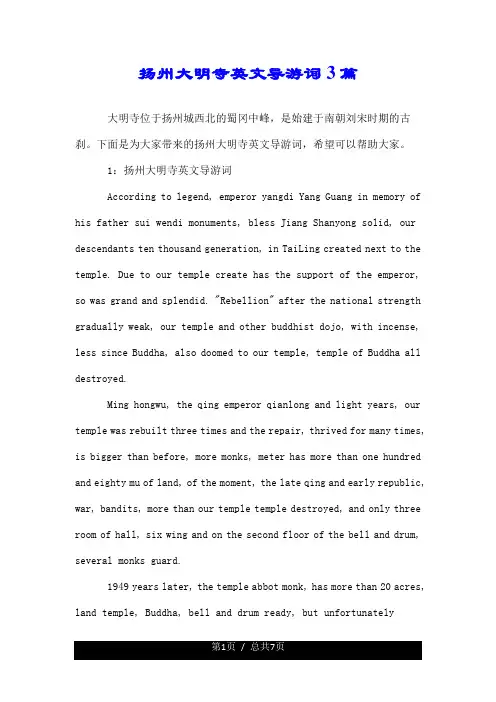
扬州大明寺英文导游词3篇大明寺位于扬州城西北的蜀冈中峰,是始建于南朝刘宋时期的古刹。
下面是为大家带来的扬州大明寺英文导游词,希望可以帮助大家。
1:扬州大明寺英文导游词According to legend, emperor yangdi Yang Guang in memory of his father sui wendi monuments, bless Jiang Shanyong solid, our descendants ten thousand generation, in TaiLing created next to the temple. Due to our temple create has the support of the emperor, so was grand and splendid. "Rebellion" after the national strength gradually weak, our temple and other buddhist dojo, with incense, less since Buddha, also doomed to our temple, temple of Buddha all destroyed.Ming hongwu, the qing emperor qianlong and light years, our temple was rebuilt three times and the repair, thrived for many times, is bigger than before, more monks, meter has more than one hundred and eighty mu of land, of the moment, the late qing and early republic, war, bandits, more than our temple temple destroyed, and only three room of hall, six wing and on the second floor of the bell and drum, several monks guard.1949 years later, the temple abbot monk, has more than 20 acres, land temple, Buddha, bell and drum ready, but unfortunatelydestroyed in the "cultural revolution". Mage advocated by the net day in 1987, under the original to our temple site restoration and reconstruction, July l989 Ursa major, change a temple called "daming monastery", take a big put light, become the government approval to legally buddhist temples. Since then, the local government, village cadres and four sides under the support of people, especially in Hong Kong publishing, holy one, the realization of the mage on the economy vigorously support, more than a decade to build without dropping out, developing very quickly. Solemn holy land of Buddhism has become a considerable scale. Temple covers an area of acres with Ursa now 5 rooms, great hall 5, ZhaiTan between two layers of 14, he was the 3 rooms, three kuan ti temple temple and chanting hall, study hall, store kingle, drum tower, etc, and have electric room, a bathroom, a guest, wing and other supporting facilities.Now daming monastery, have taken on a new look. Here is only 10 li away from the county seat, the transportation is convenient. Monastery in FeiFeng ShanYuan built, commanding, eye shot is open, large south the white snow, and west is west gaps back river, north to look deep famen temple pagoda, the east sui wendi TaiLing relatively. Lush scenery elegant, pleasant climate, flowers and trees. Is a wonderful place, temple central Ursa major iron tip ofthe roof center for SuiTai mausoleum's top of the east, east illicit affair, namely using theodolite, nor partial silk recommend her. Is this the ancients' masterpiece, deliberately or providence of close, remains unknown, but it makes people wonder, more make people feel mysterious. On the top of the temple in langfang long a towering cooper, dangling, for hundreds of years, despite the wind and rain, fighting, but still flourish, pilgrims and tourists all sigh for the spectacle.2:扬州大明寺英文导游词Daming monastery is famous at home and abroad, its long history, it is important, but more important for one reason, because there was a greatness monk, he is the distinguishing of the monk in the tang dynasty. On distinguishing the monks who speak law ChuanJie daming monastery, famous and admired by character, has the high prestige, "the reputation of jianghuai master". Thrive in Buddhism, buddhist Oriental, he accepts the Japanese buddhist invitation, readily led the monk dongdu fuso. Master dongdu buddhist is absolute. At that time, his disciples for the road far away, "the sea miaotuo overflowing, useless to", but hesitates along. Distinguishing but undaunted: "to be hurrying, also precious little body life? The people don't go, I go to the ear that!" It serves to show his profound super-knowledge and strong determination.Distinguishing the master take the bull by the horns, five times failure, did not lose heart, never flinch, finally in tianbao twelve years (753), with the blind, arrived in Japan in the 66 - year - old success always. His indomitable willpower, enables us to admire and respect. Distinguishing in Japan built temple Buddha, wide spread Buddhism commandment, xing teach calligraphy and painting skills, promote medicine diet, carrying forward the culture of datang, by the people of Japan as a benefactor "culture". Distinguishing the master is a shining example of a missionary of buddhist, is the Chinese people's friendly messenger. He is doctrines on rare elite in China, is one of the biggest glory and pride of daming monastery.Habitat spirit, a total of nine layers, was founded in the first year of SuiRenShou (601), tang dynasty poet li bai, cross, Liu Changqing, Jiang Huan, Chen Run, liu yuxi, bai juyi have to board, and leave song, reflects is known as "China YouJun" habitat of spirit majestic, magnificent towering cloud.Habitat spirit since Tang Huichang three years (843) not to be, daming monastery only ruins "habitat" spirit, without their spi tower, pilgrims and visitors are deeply lead to shame. The emperor song zhenzong JingDe first year (1004), monks can zheng to raise funds to build up a more than seven pagodas. The pagoda in thesouthern song dynasty destroy Pi again, since then, daming monastery never rebuild their spirit.As in 1980, distinguishing masters like back to yangzhou "visit" from Japan, people from all walks of life initiative to rebuild their spirit, excitation figure macro industry. Daming monastery monks with the support of relevant departments, in every way to raise money, ready to build. 1988, daming monastery monk ruixiang mage ZeZhi based at temple east garden, grand ceremony, stone for the record. Ruixiang mage parinirvana after can fix the mage persist its ambition, collect alms, pencil-thin operation, the desire for built a habitat spirit as soon as possible.Habitat and * spirit north the steps in the direct connect to lie. Lie Wu Buddha hall for the shan temple architecture, cornices, newborn magnificence. Lie the Buddha hall built in high stylobate, eaves hung * "lie" gold plaque in the middle of place, from the President of the calligraphy at the beginning of the buddhist association of China.In Ursa major as the main body of the north and south by east of central axis position, also formed a north-south central axis of the building group, and it is the main hall in distinguishing memorial as a group, the construction of the main body of the design, structure system is perfect, is almost in this building.PingShanTang locates the west side of the "old house" immortal of daming monastery Ursa major, as the northern song dynasty writer ouyang xiu in yangzhou was positively build, is consists of PingShanTang, GuLinTang, ouyang shrine, from south to north lined up. This church there hang "merry wan in", "sit on" plaques, north hall eaves hang Lin zhao yuan topic "mountains to the readings and flat" plaques. At this point, tourists SiGu of compassion.3:扬州大明寺英文导游词Daming monastery is located in yangzhou city in northwest sichuan, 27, was built in the southern dynasty liu song period of the ancient temple.Distinguishing the master had presided over the temple in the tang dynasty, to pass on one's experience about law. Temple built nine layers of a habitat of spirit. Today daming monastery in distinguishing memorial hall for the tang dynasty style architecture, distinguishing in 1963 died when the 00th anniversary of the foundation, built in 1973, the main hall of worship with dry paint on 须弥座 clip made distinguishing storage cave, close the meditation, persistent, peace. Its front yard has more than one plant height when the rare flower Joan, lush leaves, spring blossoms as white as tracts, have the reputation of "yangzhou qionghua, the unique thing in the world". To daming monastery I saw people liketide, just went in to see there is a big sign, reading: "Ursa" four characters, once we worship the Buddha inside.Finally, we came to live spirit. After entering their spirit inside there are four Buddha, are all the same, we have been to climb, to climb to the seventh layer have been exhausted, climb to the top to rest for a while, for air, air to continue to climb again. Finally climbed to the ninth floor, I feel very proud and very happy, I told mom and dad said: "I'm so happy, the wind is very comfortable!"I look down, the good little, as if some toys, people like only small ants crawling around, and I look ahead in the distance, originally the world is so big!Down after saw a tower and a drum. Leave is always coming, the day is so happy!。
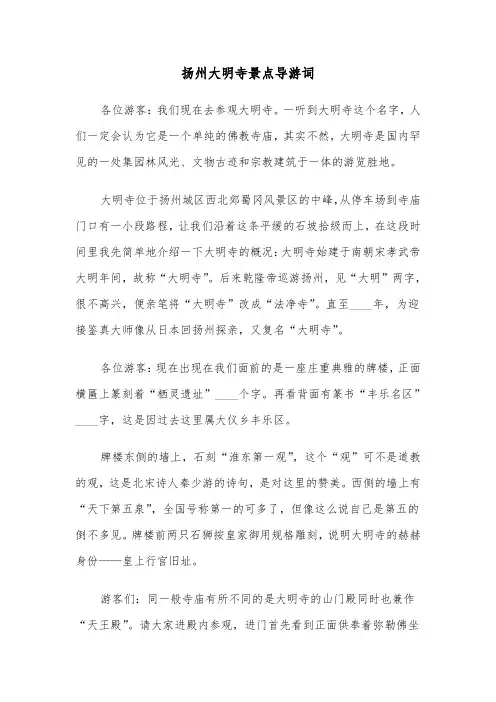
扬州大明寺景点导游词各位游客:我们现在去参观大明寺。
一听到大明寺这个名字,人们一定会认为它是一个单纯的佛教寺庙,其实不然,大明寺是国内罕见的一处集园林风光、文物古迹和宗教建筑于一体的游览胜地。
大明寺位于扬州城区西北郊蜀冈风景区的中峰,从停车场到寺庙门口有一小段路程,让我们沿着这条平缓的石坡拾级而上,在这段时间里我先简单地介绍一下大明寺的概况:大明寺始建于南朝宋孝武帝大明年间,故称“大明寺”。
后来乾隆帝巡游扬州,见“大明”两字,很不高兴,便亲笔将“大明寺”改成“法净寺”。
直至____年,为迎接鉴真大师像从日本回扬州探亲,又复名“大明寺”。
各位游客:现在出现在我们面前的是一座庄重典雅的牌楼,正面横匾上篆刻着“栖灵遗址”____个字。
再看背面有篆书“丰乐名区”____字,这是因过去这里属大仪乡丰乐区。
牌楼东侧的墙上,石刻“淮东第一观”,这个“观”可不是道教的观,这是北宋诗人秦少游的诗句,是对这里的赞美。
西侧的墙上有“天下第五泉”,全国号称第一的可多了,但像这么说自己是第五的倒不多见。
牌楼前两只石狮按皇家御用规格雕刻,说明大明寺的赫赫身份——皇上行宫旧址。
游客们:同一般寺庙有所不同的是大明寺的山门殿同时也兼作“天王殿”。
请大家进殿内参观,进门首先看到正面供奉着弥勒佛坐像,两侧有一副对联:“大腹能容,容天下难容之事;慈颜常笑,笑世间可笑之人。
”此联为明太祖朱元璋所撰。
弥勒的后面站像是护法神韦驮。
在大殿的东西两侧排列着四大天王。
扬州大明寺景点导游词(2)大明寺位于江苏省扬州市邗江区广陵北门延陵路,是中国历史文化名城扬州的著名景点之一。
大明寺作为一座古老而庄严的寺庙,拥有着丰富的历史文化底蕴,吸引着众多游客前来参观。
下面就为大家介绍一下这座寺庙的特色和景点。
大明寺创建于南朝梁武帝大同元年(527年),距今已有近1500年的历史。
寺庙占地面积广阔,总面积达5.5万平方米,是一座规模宏大的古建筑群。
大明寺曾多次毁于战火,重建于明代正德年间,后经过多次修缮扩建,修建了诸多建筑群,如山门、钟楼、鼓楼、大雄宝殿等。

扬州大明寺导游词文档4篇Guide words of Daming Temple in Yangzhou编订:JinTai College扬州大明寺导游词文档4篇前言:导游词是导游人员引导游客观光游览时的讲解词,是导游员同游客交流思想,向游客传播文化知识的工具,也是应用写作研究的文体之一。
本文档根据导游词内容要求和针对旅游地点是江苏的特点展开说明,具有实践指导意义,便于学习和使用,本文下载后内容可随意调整修改及打印。
本文简要目录如下:【下载该文档后使用Word打开,按住键盘Ctrl键且鼠标单击目录内容即可跳转到对应篇章】1、篇章1:1:扬州大明寺导游词文档2、篇章2:2:扬州大明寺导游词文档3、篇章3:3:扬州大明寺游记文档4、篇章4:扬州大明寺导游词文档扬州大明寺位于江苏省扬州市区西北郊蜀岗。
下面是为大家带来的扬州大明寺导游词,希望可以帮助大家。
篇章1:1:扬州大明寺导游词文档大明寺之所以名扬海内外,其悠久历史固然是重要原因,但更重要的一个原因,是因为这里曾经出了一位大德高僧,他就是唐代的鉴真和尚。
鉴真和尚曾在大明寺讲律传戒,名闻遐迩,为僧俗所景仰,有着崇高威望,享“江淮化主”之誉。
为了兴隆佛教,弘法东洋,他接受日本僧人邀请,欣然率领众僧东渡扶桑。
大师东渡弘法是义无反顾的。
当时,他的弟子们因道路遥远,“沧海淼漫,百无一至”,而犹豫踟蹰。
鉴真却毅然决然:“为是法事也,何惜身命?诸人不去,我即去耳!”足见他的深远识见和坚强决心。
鉴真大师不畏艰险,五次东渡失败,却毫不灰心,决不退缩,终于在天宝十二年(753),以双目失明之66岁高龄成功抵达日本,实现夙愿。
他的百折不回的坚强意志,令后人无比景仰与敬慕。
鉴真在日本传播佛教戒律、兴造寺庙佛像、广授书画技艺、推广医药饮食、弘扬大唐文化,被日本人民奉为“文化恩人”。
鉴真大师是传教弘法的光辉典范,是中国人民的友好使者。
他是中国佛教史上罕见的杰出人物,也是大明寺最大的荣耀和骄傲。
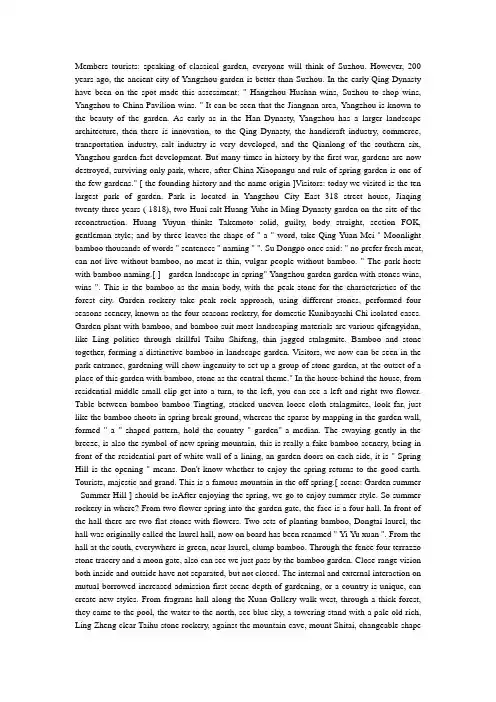
Members tourists: speaking of classical garden, everyone will think of Suzhou. However, 200 years ago, the ancient city of Yangzhou garden is better than Suzhou. In the early Qing Dynasty have been on the spot made this assessment: " Hangzhou Hushan wins, Suzhou to shop wins, Yangzhou to China Pavilion wins. " It can be seen that the Jiangnan area, Yangzhou is known to the beauty of the garden. As early as in the Han Dynasty, Yangzhou has a larger landscape architecture, then there is innovation, to the Qing Dynasty, the handicraft industry, commerce, transportation industry, salt industry is very developed, and the Qianlong of the southern six, Yangzhou garden fast development. But many times in history by the first war, gardens are now destroyed, surviving only park, where, after China Xiaopangu and rule of spring garden is one of the few gardens." [ the founding history and the name origin ]Visitors: today we visited is the ten largest park of garden. Park is located in Yangzhou City East 318 street house, Jiaqing twenty-three years ( 1818), two Huai salt Huang Y uhe in Ming Dynasty garden on the site of the reconstruction. Huang Yuyun thinks Takemoto solid, guilty, body straight, section FOK, gentleman style; and by three leaves the shape of " a " word, take Qing Yuan Mei " Moonlight bamboo thousands of words " sentences " naming " ". Su Dongpo once said: " no prefer fresh meat, can not live without bamboo, no meat is thin, vulgar people without bamboo. " The park hosts with bamboo naming.[ ] - garden landscape in spring" Yangzhou garden garden with stones wins, wins ". This is the bamboo as the main body, with the peak stone for the characteristics of the forest city. Garden rockery take peak rock approach, using different stones, performed four seasons scenery, known as the four seasons rockery, for domestic Kunibayashi Chi isolated cases. Garden plant with bamboo, and bamboo suit most landscaping materials are various qifengyidan, like Ling politics through skillful Taihu Shifeng, thin jagged stalagmite. Bamboo and stone together, forming a distinctive bamboo in landscape garden. Visitors, we now can be seen in the park entrance, gardening will show ingenuity to set up a group of stone garden, at the outset of a place of this garden with bamboo, stone as the central theme." In the house behind the house, from residential middle small clip get into a turn, to the left, you can see a left and right two flower. Table between bamboo bamboo Tingting, stacked uneven loose cloth stalagmites, look far, just like the bamboo shoots in spring break ground, whereas the sparse by mapping in the garden wall, formed " a " shaped pattern, hold the country " garden" a median. The swaying gently in the breeze, is also the symbol of new spring mountain, this is really a fake bamboo scenery, being in front of the residential part of white wall of a lining, an garden doors on each side, it is " Spring Hill is the opening " means. Don't know whether to enjoy the spring returns to the good earth. Tourists, majestic and grand. This is a famous mountain in the off spring.[ scene: Garden summer - Summer Hill ] should be isAfter enjoying the spring, we go to enjoy summer style. So summer rockery in where? From two flower spring into the garden gate, the face is a four hall. In front of the hall there are two flat stones with flowers. Two sets of planting bamboo, Dongtai laurel, the hall was originally called the laurel hall, now on board has been renamed " Yi Yu xuan ". From the hall at the south, everywhere is green, near laurel, clump bamboo. Through the fence four terrazzo stone tracery and a moon gate, also can see we just pass by the bamboo garden. Close-range vision both inside and outside have not separated, but not closed. The internal and external interaction on mutual borrowed increased admission first scene depth of gardening, or a country is unique, can create new styles. From fragrans hall along the Xuan Gallery walk west, through a thick forest, they came to the pool, the water to the north, see blue sky, a towering stand with a pale old rich, Ling Zheng clear Taihu stone rockery, against the mountain cave, mount Shitai, changeable shapeposture, shape like the clouds in the sky, it's summer hill. Piedmont is a limpid pool, water has a curved bridge, leading to the entrance, cleverly hide the water tail, give a person with " how deep is the courtyard ". Pool planted lotus, look, " bright red lotus ", highlighting the " summer " theme of artistic conception.Walking in the curved bridge, we can enjoy the summer hill beauty, and on both sides of some such as Wang He stone as independent, form; some may see segment of a whole, charmingly naive. Look up, Taniguchi on flying outside the pick, as the magpie plum, meet the guests; the long jump, the group already had, be overwhelmed with joy. It was king Qiao stone, so dizzying. Enter the cavern, just beginning to feel a little eerie, then used inclined top stone gap falling trace of light, feel spacious cavern. But in a little pond water and divides an inflow hole, plus stone color is green ash, summer in the hole and enjoy the scenery, but feel cool. Cavern can go through, level up, turn on the number to make to the top of the mountain. There is a small pavilion was isolated from the rockery. Before leaving is a means of projecting, cliff, add to the summer mountain lush atmosphere. Standing in the booth, look back in the cave stone, rockery, Yulan complicated and difficult to deal with, the stone steps flanked, rain stand gracefully erect. Walking in the meantime, he sprinkled green shade phi, groves, really lets the human feel heart is refreshing.[ scene: Mount Huangshan garden stone - Akiyama ]Members tourists: if the summer is to have fresh gentle curves of Taihu stone show fair quiet mood, then fall to Mount Huangshan stone rough Haofang expansion linear performance of broad magnificent magnificent. Because of the Mount Huangshan stone has both north and South Mountain, male, landscape of the show, it is the most picturesque Akiyama garden rockery. The rockery, with cliffs on Anhui beach of Huangshi, its color is yellow stone some reservoir, some red as dye. Rockery main faces west, whenever the sundowners, Hongxia mapping, color is very eye-catching. On the cliff stone gap, and the pine stand, its green leaves brown with yellow rocks in contrast, like a piece of a picture. Mountain has a Square Pavilion, in which, overlooking the surrounding landscape to the north, overlooking the green Yang City Guo, Slender West Lake, Pingshan hall and a Buddism godness Guanyin Mountain from King and a garden, this is also the Chinese traditional gardening practices -- by the king. In ancient China, to the autumn high-sighted tradition. Mount Huangshan Stone Park is the commanding elevation, with the climb to render the autumn theme.Akiyama shape tall towering, complicated internal structure. Cave, Shitai, they may, with mountain Chalet Shilianghe staggered together, forming a whirling in the three-dimensional access visit, it not only has a planar roundabout, a more three-dimensional zigzag. Visitors, if you are interested, can from mountain and floor by floor, two hill, slowly to enjoy this ingenious design, stacking technique high mountains of Yangzhou -- a style.[ landscape winter landscape: ventilation leakage Yue Xuan - drain business ]From Huangshi south to the rockery, three surplus building in the west, there is a quiet area, the region 's main building is a North and south open up, things wall enclosed small hall, the building has given people the feeling seems to take some " jingwei ". Please look at the house, the smaller roof warping, more gentle, modelling is relatively heavy, why? Originally in the Qing Dynasty emperor prosperity, South, to play in Yangzhou. Yangzhou city economic strength, for the so-called " Ying Luang " tax one's ingenuity, to try to figure out the emperor 's preferences, so there are a lot of landscape architecture is modeled after the Beijing architectural style, gradually, gardens of Yangzhou some building with some " jingwei ". This building is called the " ventilation leakage month " small hall is no exception. In the south of the hall there is a sun stone flat flowers, table on garden south wall, and declared the heap up small leaning against the wall rock, this is the winter hill. Sun stone produced in Anhui, Xuancheng, its color is white as snow,people also call it snow stone. This scenic area, is the winter snow tea stove, side edge. In order to make rockery in snow when there is still snow, will announce on wall rock of South North wall, from the hall looked, Station Hill color is white, like the snow did not disappear. Because the sun stone contains quartz, its color is white, but in the sun shine, as will their at Sunningdale, with some snow theme behind shady, winter hill, visible also mountain home to observe carefully.Sun hill on the east side of the wall, is the park entrance. In order to make the winter means more foot, the gardeners in the wall have regularly arranged 24 round holes, a component of the leaking window picture have a style of one's own. Whenever the wind blow, the entrance is a flute sound hole on, will send out different sounds, like winter northwest wind call, to sound to assist the theme conception. More subtle is, through the rows of air leakage on round, see is the spring bamboo, stalagmite. If friends have no " winter to spring " of the association.[ summary ] garden landscape gardening artVisitors: in the park area planning, Garden owners in accordance with the main tour routes in clockwise direction, layout of the spring, summer, autumn, winter around the rockery stone, novel, fine material, background harmony, tight structure. In these hills theme landscape sequence, seasonal characteristic is the creation, Haruyama is enlightenment, Summerhill is unfolded, Akiyama is the climax, winter hill is the end, like music or write that, with strict rules.Members tourists: garden rockery summed up the so-called " Spring Hill on the metallurgical and such as laughter, summer hill green, such as drop, such as cosmetics Akiyama is clear and winter hill, bleak, such as sleep " and " Spring Hill should travel, summer Shanyi, Akiyama Norito, winter Hill livable " painting theory. There are " appropriate is ", "hold the hill house ", " cloud brush Pavilion ", " live " Autumn Pavilion ", air leakage through Yue Xuan " and other ancient buildings. Four seasons rockery Pavilion in the set, and the ancient and famous trees embellished the meantime, more simple and elegant, deep, magnificent. Some people say: " King Stone four standard wrinkle, thin, transparent, leakage ", it seems a foregone conclusion, but it is generally rock skills, such as " peak of man-made stone, constitute a four-season rockery, garden week tours, like a year, which shows the different special custom constitution; more valuable the spring summer and autumn, winter is not an isolated individual apart, but like nature itself -- highest quality. Although the snow winter scene to still the feeling. But by the spring on the west wall has opened two circular window, Tadami Edaeda bamboo over, and give people a " winter live split spring " the far-reaching artistic conception, the landscape is like a huge picture of the dynamics of structure, harmony.The tourists: " the main landscape has been touring ended. In the tour. ", maybe you and I also issued a heartfelt sigh: Yangzhou Park, it is the garden of the essence of the garden.。
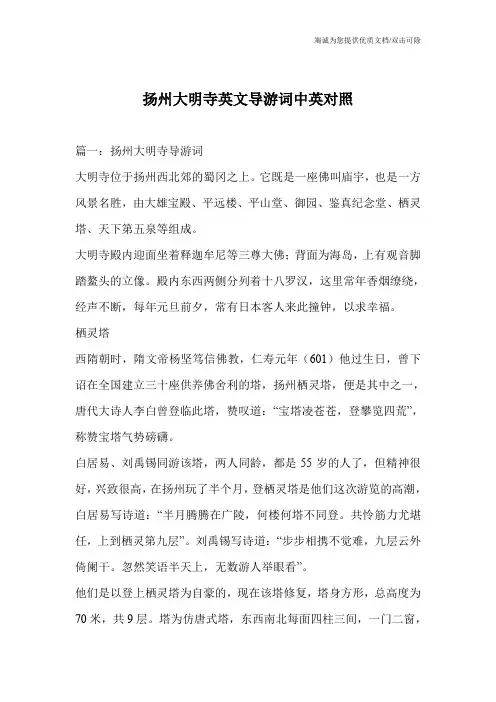
扬州大明寺英文导游词中英对照篇一:扬州大明寺导游词大明寺位于扬州西北郊的蜀冈之上。
它既是一座佛叫庙宇,也是一方风景名胜,由大雄宝殿、平远楼、平山堂、御园、鉴真纪念堂、栖灵塔、天下第五泉等组成。
大明寺殿内迎面坐着释迦牟尼等三尊大佛;背面为海岛,上有观音脚踏鳌头的立像。
殿内东西两侧分列着十八罗汉,这里常年香烟缭绕,经声不断,每年元旦前夕,常有日本客人来此撞钟,以求幸福。
栖灵塔西隋朝时,隋文帝杨坚笃信佛教,仁寿元年(601)他过生日,曾下诏在全国建立三十座供养佛舍利的塔,扬州栖灵塔,便是其中之一,唐代大诗人李白曾登临此塔,赞叹道:“宝塔凌苍苍,登攀览四荒”,称赞宝塔气势磅礴。
白居易、刘禹锡同游该塔,两人同龄,都是55岁的人了,但精神很好,兴致很高,在扬州玩了半个月,登栖灵塔是他们这次游览的高潮,白居易写诗道:“半月腾腾在广陵,何楼何塔不同登。
共怜筋力尤堪任,上到栖灵第九层”。
刘禹锡写诗道:“步步相携不觉难,九层云外倚阑干。
忽然笑语半天上,无数游人举眼看”。
他们是以登上栖灵塔为自豪的,现在该塔修复,塔身方形,总高度为70米,共9层。
塔为仿唐式塔,东西南北每面四柱三间,一门二窗,平座腰檐,出檐深远,屋面平坡,腰鼓形柱,直棂形窗。
塔雄踞蜀岗之上,气势雄伟,古朴典雅,远观似孤峰耸秀,矗入云霄;登临则眼界顿开,胸襟旷达。
鉴真纪念堂扬州鉴真纪念堂是为纪念唐朝律学高僧鉴真而建。
鉴真是当时淮南地区极有名望的佛教首领,他拜唐代律宗祖师道岸为师,受请东渡日本传法,于奈良东大寺设坛传戒,又创建唐招提寺,成为日本律宗初祖。
鉴真是友好使者,他曾六次东渡,历时十年,虽双目失明而矢志不渝,在日十年不仅辛勤传法,而且把唐代绘画、书法、雕塑、医药、工艺、印刷、建筑等成就的文化带至日本,实际上是一僧团形式的文化代表团。
他使魏晋以来中日两国人民互相友好的夙愿和以圆满的实现。
1963年鉴真圆寂1200周年,中日双方商定,举行隆重的纪念仪式,我佛教协会主席赵朴初和日本佛教首领大谷莹润分别代表两国鉴真纪念委员会,商定在此建造纪念堂,1973年动工,1974年竣工。
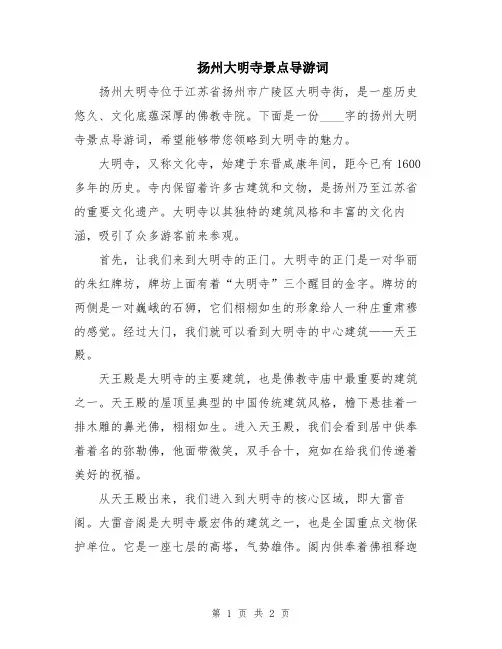
扬州大明寺景点导游词扬州大明寺位于江苏省扬州市广陵区大明寺街,是一座历史悠久、文化底蕴深厚的佛教寺院。
下面是一份____字的扬州大明寺景点导游词,希望能够带您领略到大明寺的魅力。
大明寺,又称文化寺,始建于东晋咸康年间,距今已有1600多年的历史。
寺内保留着许多古建筑和文物,是扬州乃至江苏省的重要文化遗产。
大明寺以其独特的建筑风格和丰富的文化内涵,吸引了众多游客前来参观。
首先,让我们来到大明寺的正门。
大明寺的正门是一对华丽的朱红牌坊,牌坊上面有着“大明寺”三个醒目的金字。
牌坊的两侧是一对巍峨的石狮,它们栩栩如生的形象给人一种庄重肃穆的感觉。
经过大门,我们就可以看到大明寺的中心建筑——天王殿。
天王殿是大明寺的主要建筑,也是佛教寺庙中最重要的建筑之一。
天王殿的屋顶呈典型的中国传统建筑风格,檐下悬挂着一排木雕的鼻光佛,栩栩如生。
进入天王殿,我们会看到居中供奉着着名的弥勒佛,他面带微笑,双手合十,宛如在给我们传递着美好的祝福。
从天王殿出来,我们进入到大明寺的核心区域,即大雷音阁。
大雷音阁是大明寺最宏伟的建筑之一,也是全国重点文物保护单位。
它是一座七层的高塔,气势雄伟。
阁内供奉着佛祖释迦牟尼的塑像,以及许多佛经和佛教文物。
登上大雷音阁顶层,可以俯瞰整个大明寺的景色,视野开阔,令人心旷神怡。
从大雷音阁出来,我们来到大明寺的后山区域。
在这里,有一座名为“天下第一佛” 的黄金佛像,是全球最大的黄金佛像。
这尊黄金佛像高达88米,金光闪闪,辉映着整个城市。
无论是远观还是近观,都令人叹为观止。
它被誉为“扬州新地标”,成为了游客们来扬州必到的景点之一。
除了以上的景点,大明寺还建有多个大殿、小殿和佛塔等,如水月观音殿、法堂、藏经楼等。
这些建筑都充满了佛教的神秘和庄严,让人感受到宁静和美好。
同时,寺内还有多处古树参天,花草繁茂,气氛宜人,是一个理想的休闲观光场所。
此外,大明寺还举办着各种佛教法会和文化活动,如佛诞节、清明节、中秋节等。
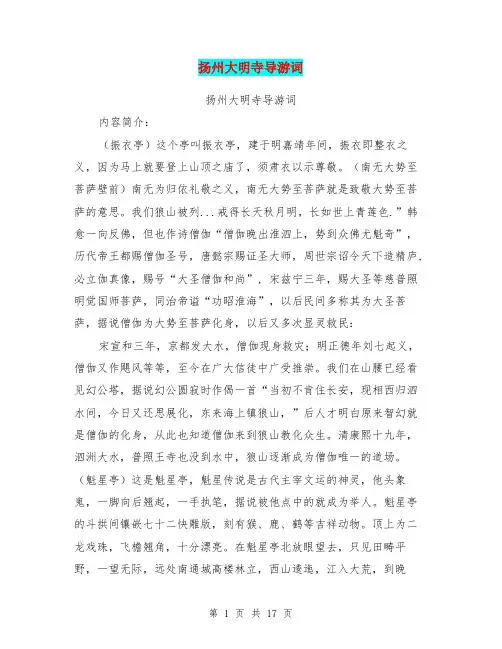
扬州大明寺导游词扬州大明寺导游词内容简介:(振衣亭)这个亭叫振衣亭,建于明嘉靖年间,振衣即整衣之义,因为马上就要登上山顶之庙了,须肃衣以示尊敬。
(南无大势至菩萨壁前)南无为归依礼敬之义,南无大势至菩萨就是致敬大势至菩萨的意思。
我们狼山被列...戒得长天秋月明,长如世上青莲色.”韩愈一向反佛,但也作诗僧伽“僧伽晚出淮泗上,势到众佛尤魁奇”,历代帝王都赐僧伽圣号,唐懿宗赐证圣大师,周世宗诏令天下造精庐,必立伽真像,赐号“大圣僧伽和尚”, 宋兹宁三年,赐大圣等慈普照明觉国师菩萨,同治帝谥“功昭淮海”,以后民间多称其为大圣菩萨,据说僧伽为大势至菩萨化身,以后又多次显灵救民:宋宣和三年,京都发大水,僧伽现身救灾;明正德年刘七起义,僧伽又作飓风等等,至今在广大信徒中广受推崇。
我们在山腰已经看见幻公塔,据说幻公圆寂时作偈一首“当初不肯住长安,现相西归泗水间,今日又还思展化,东来海上镇狼山,”后人才明白原来智幻就是僧伽的化身,从此也知道僧伽来到狼山教化众生。
清康熙十九年,泗洲大水,普照王寺也没到水中,狼山逐渐成为僧伽唯一的道场。
(魁星亭)这是魁星亭,魁星传说是古代主宰文运的神灵,他头象鬼,一脚向后翘起,一手执笔,据说被他点中的就成为举人。
魁星亭的斗拱间镶嵌七十二快雕版,刻有猴、鹿、鹤等吉祥动物。
顶上为二龙戏珠,飞檐翘角,十分漂亮。
在魁星亭北放眼望去,只见田畴平野,一望无际,远处南通城高楼林立,西山逶迤,江入大荒,到晚上,万家灯火,灿若繁星,好一派壮美景象!·寒山寺导游词·江苏周庄导游词·扬州瘦西湖导游词·淮安市导游词·夫子庙导游词%各位游客:我国以“西湖”命名的景区有三四十处之多,而“瘦西湖”仅扬州一个。
那么她为什么要定名为“瘦西湖”呢?瘦西湖地处扬州城西郊,原名“炮山河”,亦称“保障河”,是隋唐时期由蜀同诸山之水,汇合安徽大别山东来的洞水流人运河的一段水道。
它有50多公顷的游览面积,6公里多的游程,一条曲水如锦带,时展时收,犹如嫦娥起舞时抛向人间的五色飘带,形态自然动人。
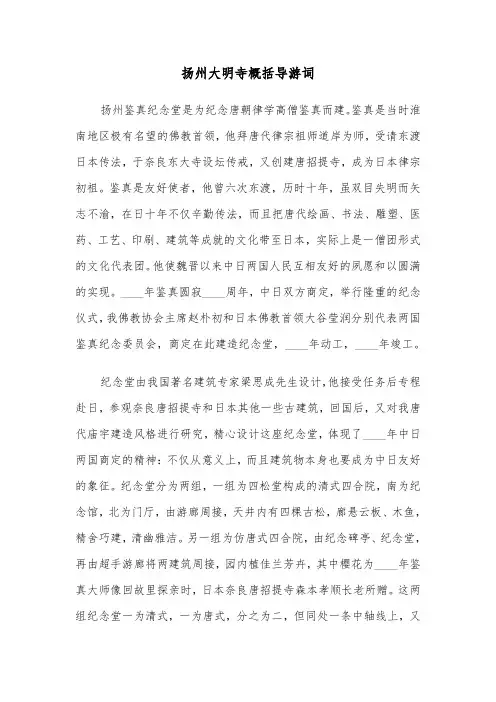
扬州大明寺概括导游词扬州鉴真纪念堂是为纪念唐朝律学高僧鉴真而建。
鉴真是当时淮南地区极有名望的佛教首领,他拜唐代律宗祖师道岸为师,受请东渡日本传法,于奈良东大寺设坛传戒,又创建唐招提寺,成为日本律宗初祖。
鉴真是友好使者,他曾六次东渡,历时十年,虽双目失明而矢志不渝,在日十年不仅辛勤传法,而且把唐代绘画、书法、雕塑、医药、工艺、印刷、建筑等成就的文化带至日本,实际上是一僧团形式的文化代表团。
他使魏晋以来中日两国人民互相友好的夙愿和以圆满的实现。
____年鉴真圆寂____周年,中日双方商定,举行隆重的纪念仪式,我佛教协会主席赵朴初和日本佛教首领大谷莹润分别代表两国鉴真纪念委员会,商定在此建造纪念堂,____年动工,____年竣工。
纪念堂由我国著名建筑专家梁思成先生设计,他接受任务后专程赴日,参观奈良唐招提寺和日本其他一些古建筑,回国后,又对我唐代庙宇建造风格进行研究,精心设计这座纪念堂,体现了____年中日两国商定的精神:不仅从意义上,而且建筑物本身也要成为中日友好的象征。
纪念堂分为两组,一组为四松堂构成的清式四合院,南为纪念馆,北为门厅,由游廊周接,天井内有四棵古松,廊悬云板、木鱼,精舍巧建,清幽雅洁。
另一组为仿唐式四合院,由纪念碑亭、纪念堂,再由超手游廊将两建筑周接,园内植佳兰芳卉,其中樱花为____年鉴真大师像回故里探亲时,日本奈良唐招提寺森本孝顺长老所赠。
这两组纪念堂一为清式,一为唐式,分之为二,但同处一条中轴线上,又合之为一。
扬州大明寺概括导游词(2)大家好,欢迎来到扬州大明寺!作为中国佛教三大名刹之一,大明寺是扬州最著名的旅游景点之一,也是扬州佛教文化的重要象征。
下面我将为大家介绍扬州大明寺的历史、建筑和文化内涵。
大明寺坐落在江苏省扬州市的广陵区,始建于东晋咸康年间,至今已有1600余年的历史。
这座寺庙最初是由一位名叫顾维钧的佛教高僧创建的,他为了弘扬佛教教义,在扬州建造了这座宏伟壮丽的寺庙。

扬州大明寺导游词扬州大明寺导游词篇10扬州大明寺导游词篇12五代毛文锡《茶谱》中称“扬州禅智寺,隋之故宫,寺旁蜀岗有茶园,其茶甘香,味如蒙顶。
”(蒙顶,是四川峨嵋蒙山之顶,山顶之茶是唐珍品,白居易曾作诗云“扬子江中水,蒙山顶上茶”)。
当时蜀岗茶还作为贡品进贡,至今蜀岗有茶树五百亩,其茶以芽尖鲜嫩,条索紧密,汤色明亮,清香浓重为宇内称道。
扬州不仅茶叶好,而且讲究泡制,首先是水,最好的冲茶水当为五泉水。
唐代状元张又新写《煎茶水记》,说唐代宗时李秀卿出任湖州刺史路经维扬,逢陆羽,李早闻陆之大名,十分倾慕,相聚甚欢。
当他们的船泊于扬子江边准备吃饭时,李秀卿说,“陆君善于别茶天下闻名,而扬子江南零水又殊绝,难得今日二妙千载一遇,岂能错过?”陆羽欣然应允,于是李秀卿令谨慎可靠的军士携瓶操舟,深入扬子江南零取水,陆羽准备好茶具相候。
不一会,水取来了,陆羽以杓扬其水,说:“这是扬子江中水不假,但不是南零水,而是近岸之水。
”军士说“我划船深入,而且有百人做证”。
陆羽不言语,让他端起盆,把水倒入另一盆中,倒及一半时,又以杓扬之,说“以下都是南零水了”。
兵士惊吓不已,跪地请罪。
原来他最初确实是在南零取的水,可惜近岸时,舟荡水泼了一半,于是就近以江水加满。
李秀卿和宾客都大为惊叹,恳请陆羽口授天下之水的优劣,陆羽说:扬子江江南零水第七,惠山水第二,虎丘水第五,丹阳水第十一,扬州大明寺水第十二。
陆羽之后的刘伯刍也是位学识渊博者,把江淮最宜于烹茶的水分为七等,扬子江南零水第一,无锡惠山寺石水第二,苏州虎丘寺石水第三,丹阳县观音寺水第四,吴淞江水第六,淮水最下第七。
扬州蜀岗中峰大明寺水名列第五。
北宋欧阳修守扬州时,曾品尝该泉水,并在井上建“美泉亭”,还撰《大明寺泉水记》,称赞泉水之美。
苏东坡守扬州时曾记道:“大明寺塔院西廊井与下院蜀井的水,以塔院为胜。
”真是:从来名士能评水,自古高僧爱斗茶。
过去此处一直有塔井和下院井之说,明代大明寺僧沧溟曾掘地得井,嘉靖中叶,巡盐御史徐九皋书“第五泉”三字,青石红字,字形丰腴壮丽,人称此为下院井。

游览线路:牌楼—山门殿—大雄宝殿—鉴真纪念堂—欧公祠—西园遗址—乾隆碑亭—康熙碑亭—平山堂—栖(qi)灵塔大明寺导游词简介:大明寺地处扬州北郊蜀冈——瘦西湖风景区内的蜀冈中峰,南邻瘦西湖,是个“前有照,背有靠”的风水宝地,它历史悠久,是集佛教庙宇、文物古迹、园林风光于一体的宗教旅游胜地,享有“淮东第一观”的盛名。
大明寺始建于南朝刘宋(宋孝武帝刘骏)大明年间(457—464年),依当年年号“大明”而叫“大明寺”,(因寺内建有栖(qi)灵塔,又称“栖灵寺”;又因为其位于唐城之西,亦称“西寺”)距今已有一千五百年的历史。
到了清代,乾隆皇帝1765年第四次南巡,看到“大明”二字很不高兴,认为扬州人思念大明朝,故改名为“法净寺”。
而扬州人不接受此名,一般称其为“平山堂”,以局部代全局。
这样一直延续到1980年,由于大明寺是国际文化使者鉴真大和尚的祖庭,国家处于对外交往的需要,1980年重新恢复为大明寺,成为我国改革开放后最早对外开放的寺庙,目前是国家4A级景点。
(寺内有始建于隋代的栖灵塔、唐代鉴真大和尚的纪念堂、北宋欧阳修的平山堂、清代康熙、乾隆两位皇帝的行宫遗址等古迹,是我国著名的园林寺。
)(上山的石台阶共168级)(东面序墙上看到五个石刻大字“淮东第一观”,这个“观”可不是道教的“观”,大明寺是佛教,这句话出自北宋扬州秦少游的诗,“游人若论登临美,须作淮东第一观”,是对这里的赞美,由清代书法家蒋衡书写。
)(西序墙上还有五个字“天下第五泉”,为清代书法家王澍(shu)书写。
全国号称第一的可多了,像这么说自己是“第五”的倒不多见。
东面的“第一”很自豪,西边的“第五”又很谦虚,这些石刻都是清代留下的原物。
)牌楼:大家请看前面的牌楼,是为了纪念唐代因天火而烧毁栖灵塔而建的,木质结构,四柱三楹,南面四个篆体字叫“栖灵遗址”,转过去还可以看到背面的四个字“丰乐名区”,因为此地原来属于大仪乡丰乐区。
(隋文帝杨坚笃行佛教,仁寿元年(601年)在他过生日时,下诏在全国建立30座佛塔供奉舍利,扬州栖灵塔便是其中之一。
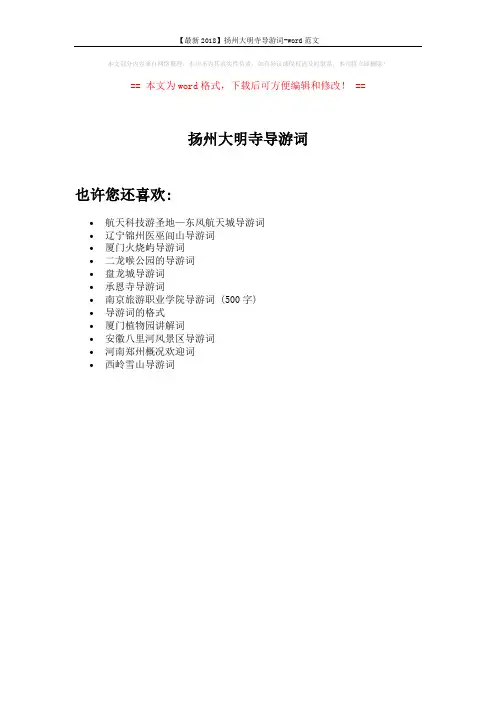
【最新2018】扬州大明寺导游词-word范文
本文部分内容来自网络整理,本司不为其真实性负责,如有异议或侵权请及时联系,本司将立即删除!
== 本文为word格式,下载后可方便编辑和修改! ==
扬州大明寺导游词
也许您还喜欢:
∙航天科技游圣地—东风航天城导游词
∙辽宁锦州医巫闾山导游词
∙厦门火烧屿导游词
∙二龙喉公园的导游词
∙盘龙城导游词
∙承恩寺导游词
∙南京旅游职业学院导游词 (500字)
∙导游词的格式
∙厦门植物园讲解词
∙安徽八里河风景区导游词
∙河南郑州概况欢迎词
∙西岭雪山导游词。
大明寺听到大明寺这个名字,人们一定会认为它是一个单纯的佛教寺庙,其实不然,它的范畴应该是“大明寺风物鉴赏区”,它是由寺庙古迹、栖灵塔、鉴真纪念堂、仙人旧馆、西苑芳圃五部分组成,是国内罕见的一处集园林风光、文物古迹和宗教建筑于一体的游览胜地。
大明寺自创建以来,向有“扬州第一名胜”之说。
1.大明寺概况大明寺位于扬州城区西北郊蜀岗风景区的中峰,从停车场到寺庙门口有一小段路程,让我们沿着这条平缓的石坡拾级而上,在这段时间里我先简单地介绍一下大明寺的概况:大明寺始建于南朝宋孝武帝大明年间(457—464年),故称“大明寺”。
隋仁寿元年(601年),隋文帝杨坚60寿辰,诏令在全国30个州内设立30座塔,以供奉舍利(佛骨),其中一座就建立在大明寺内,称“栖灵塔”。
塔高九层,因寺从塔名,故“大明寺”与“栖灵寺”并称;又因大明寺在隋宫、唐城之西,因此也称“西寺”。
清乾隆三十年(176年)乾隆帝巡游扬州,见“大明”两字,很不高兴,便亲笔将“大明寺”改成“法净寺”。
直至1980年,为迎接鉴真大师像从日本回扬州探亲,才复名“大明寺”。
2.牌楼沿着数百级舒缓石阶登上大明寺前的广场,迎面是一座庄严典雅的牌楼。
可以看到牌楼正面上有篆书“栖灵遗址”四字,是为了纪念栖灵塔被雷火劈毁而建;又因曾归属大仪乡丰乐区,因此反面有篆书“丰乐名区”四字,是出自这里的地名,这两块篆体字的都是清光绪年间盐运使姚煜手书,字体雄美。
牌楼前面有一对石狮格外引人注目,石狮按皇家园林规格雕镌,造型雄健,正头,蹲身,直腰,前爪平伏,傲视远方。
它们是扬州名刹重宁寺的古老遗物,60年代移至此处。
寺前东西院墙上分别嵌着两块石碑,东为蒋衡山“淮东第一观”,这里的观可不是道教的观,大明寺是佛教,这句话出自扬州名人秦少游的诗句"游人若论登临美,须作淮东第一观",是对这里的赞美,西为王澍书“天下第五泉”大字。
3.山门殿现在来到的是大明寺的大门,同一般寺庙有所不同的是大明寺的山门殿同时也兼作“天王殿”,我们可以看到三个大门耸立,中间比较高大的是正山门,东西则是东大门和西大门,山门是佛教和老百姓划清界限的地方,进入山门就要遵守清规戒律.现在请大家进殿内参观,进门首先看到正南面供奉着弥勒佛坐像,左手握布袋,右手持佛珠,据称他是释迦摩尼的弟子阿逸多。
大明寺导游词各位朋友,欢迎大家来到大明寺参观游览。
大明寺地处城北蜀冈中峰,它以悠久历史和优美环境,依山面水,享有“淮东第一胜境”的盛名。
众多的文物古迹,迷人的山水景观,是集佛教庙宇、文物古迹和园林风光于一体的游览胜地,古往今来高僧辈出,君王贤圣,骚人墨客,国内外风雅名流,曾云集于此,游览观光者无不流连忘返,虔诚祈求者,无不吉祥如意,福寿无量。
大明寺初建于南朝宋大明年间(457~464年),故称“大明寺”。
隋建“栖灵塔”,故“大明寺”又称“栖灵寺”;又因大明寺在隋宫、唐城之西,亦称“西寺”。
唐时,栖灵塔毁于雷火,宋代重建,不久又废圮。
于后,寺名亦由栖灵寺复名大明寺。
至清代(1765年),乾隆皇帝南巡,改名为“法净寺”。
1980年鉴真和尚塑像从日本到中国展出,称之为“回国探亲”乃恢复大明寺原名。
大明寺风物景观,由寺庙、文章奥区(栖灵塔塔院)、鉴真纪念堂。
仙人旧馆、西苑芳圃五部分组成。
请各位朋友,随我沿导游线路一一游览。
[栖灵遗址牌楼]现在我们已来到大明寺山门前,这座庄严典雅的木制牌楼,依山面水,极为壮观,四柱三楹。
中门之上朝南有篆书“栖灵遗址”四字;北有篆书“丰乐名区”四字,丰乐之名源于此地旧属大仪乡丰乐区。
[山门殿]牌楼北约20米,即大明寺正门,黄墙三门,额“大明寺”,门东侧围墙嵌有“淮东第一观”石刻,取北宋秦观诗句“游人若论登临美,须作淮东第一观”。
清代书法家蒋衡书;西侧墙上嵌“天下第五泉”石刻,为清代书法家王澍书。
进庙门,便是天王殿。
正中供奉袒胸露腹、笑口常开的弥勒佛,背后是佛教护法神韦驮立像;大殿两侧供奉四大天王雕像,分别为:南方增长天王西方广目天王、北方多闻天王、东方持国天王,均为佛门护法神,分掌风、调、雨、顺之权。
出口山门殿(天王殿)北门,为一大庭院,院中正殿为大雄宝殿。
大雄宝殿三楹三檐,三层檐下悬“大雄宝殿”横匾。
屋脊嵌有宝镜及砖刻“风调雨顺”“国泰民安”字样。
大殿前后为双步梁,加走廊。
列位游客:适才咱们领略了瘦西湖的秀色,此刻请大伙儿去参观大明寺。
一听大明寺那个名字,人们必然会以为它是一个单纯的佛教寺庙,其实不然,它的范围应该是“大明寺风物鉴赏区”由寺庙古迹、栖灵塔、鉴真纪念堂、神仙旧馆、西苑芳圃五部份组成,是国内罕有的一处集园林风光、文物古迹和宗教建筑于一体的游览胜地。
大明寺自创建以来,向有“扬州第一名胜”之说。
从1980年迎接鉴真大师像回国巡展后,每一年接待中外宾客达40万人次之多。
1991年10月12日上午,国家主席江泽民曾陪同朝鲜劳动党主席金日成前来参观。
大明寺山明水秀,景物纷呈,下面就让咱们迈入这藏龙赐福、香云线绕的吉祥之地,去一睹它的风貌吧!
【大明寺创建历史—牌楼—山门殿—大雄宝殿—藏经楼—平远楼】。
扬州大明寺导游词大明寺位于扬州西北郊的蜀冈之上。
它既是一座佛叫庙宇,也是一方风景名胜,由大雄宝殿、平远楼、平山堂、御园、鉴真纪念堂、栖灵塔、天下第五泉等组成。
大明寺殿内迎面坐着释迦牟尼等三尊大佛;背面为海岛,上有观音脚踏鳌头的立像。
殿内东西两侧分列着十八罗汉,这里常年香烟缭绕,经声不断,每年元旦前夕,常有日本客人来此撞钟,以求幸福。
栖灵塔西隋朝时,隋文帝杨坚笃信佛教,仁寿元年(601)他过生日,曾下诏在全国建立三十座供养佛舍利的塔,扬州栖灵塔,便是其中之一,唐代大诗人李白曾登临此塔,赞叹道:宝塔凌苍苍,登攀览四荒,称赞宝塔气势磅礴。
白居易、刘禹锡同游该塔,两人同龄,都是55岁的人了,但精神很好,兴致很高,在扬州玩了半个月,登栖灵塔是他们这次游览的高潮,白居易写诗道:半月腾腾在广陵,何楼何塔不同登。
欧阳修最爱莲花,其后调任安徽阜阳,到任第二天,他就来到该城的西湖之滨,见湖面开阔,但杂草丛生,于是遍植瑞莲和黄杨,使西湖顿改旧观,夏日时接天莲叶,映日荷花,于是他写诗道:菡萏香清画舸浮,使君不复忆扬州。
都将二十四桥月,换得西湖十顷秋。
可见他是按照扬州瘦西湖的景致安排阜阳的山水。
堂前朱漆红柱上的楹联:过江诸山到此堂下,太守之宴与众宾欢,是清太守伊秉绶所作,上联以山喻人,显现当年高朋慕名而至,谈古论今的盛景;下联借欧公《醉翁亭记》中句,表现欧公无法施展抱负的郁闷和乐观自适的落宕情怀。
造句既佳,书法古朴,为平山堂楹联之冠。
天下第五泉扬州人爱喝茶。
喝茶先得种茶。
扬州种茶历史悠久。
五代毛文锡《茶谱》中称扬州禅智寺,隋之故宫,寺旁蜀岗有茶园,其茶甘香,味如蒙顶。
(蒙顶,是四川峨嵋蒙山之顶,山顶之茶是唐珍品,白居易曾作诗云扬子江中水,蒙山顶上茶)。
当时蜀岗茶还作为贡品进贡,至今蜀岗有茶树五百亩,其茶以芽尖鲜嫩,条索紧密,汤色明亮,清香浓重为宇内称道。
扬州不仅茶叶好,而且讲究泡制,首先是水,最好的冲茶水当为五泉水。
唐代状元张又新写《煎茶水记》,说唐代宗时李秀卿出任湖州刺史路经维扬,逢陆羽,李早闻陆之大名,十分倾慕,相聚甚欢。
扬州大明寺英文导游词中英对照篇一:扬州大明寺导游词大明寺位于扬州西北郊的蜀冈之上。
它既是一座佛叫庙宇,也是一方风景名胜,由大雄宝殿、平远楼、平山堂、御园、鉴真纪念堂、栖灵塔、天下第五泉等组成。
大明寺殿内迎面坐着释迦牟尼等三尊大佛;背面为海岛,上有观音脚踏鳌头的立像。
殿内东西两侧分列着十八罗汉,这里常年香烟缭绕,经声不断,每年元旦前夕,常有日本客人来此撞钟,以求幸福。
栖灵塔西隋朝时,隋文帝杨坚笃信佛教,仁寿元年(601)他过生日,曾下诏在全国建立三十座供养佛舍利的塔,扬州栖灵塔,便是其中之一,唐代大诗人李白曾登临此塔,赞叹道:“宝塔凌苍苍,登攀览四荒”,称赞宝塔气势磅礴。
白居易、刘禹锡同游该塔,两人同龄,都是55岁的人了,但精神很好,兴致很高,在扬州玩了半个月,登栖灵塔是他们这次游览的高潮,白居易写诗道:“半月腾腾在广陵,何楼何塔不同登。
共怜筋力尤堪任,上到栖灵第九层”。
刘禹锡写诗道:“步步相携不觉难,九层云外倚阑干。
忽然笑语半天上,无数游人举眼看”。
他们是以登上栖灵塔为自豪的,现在该塔修复,塔身方形,总高度为70米,共9层。
塔为仿唐式塔,东西南北每面四柱三间,一门二窗,平座腰檐,出檐深远,屋面平坡,腰鼓形柱,直棂形窗。
塔雄踞蜀岗之上,气势雄伟,古朴典雅,远观似孤峰耸秀,矗入云霄;登临则眼界顿开,胸襟旷达。
鉴真纪念堂扬州鉴真纪念堂是为纪念唐朝律学高僧鉴真而建。
鉴真是当时淮南地区极有名望的佛教首领,他拜唐代律宗祖师道岸为师,受请东渡日本传法,于奈良东大寺设坛传戒,又创建唐招提寺,成为日本律宗初祖。
鉴真是友好使者,他曾六次东渡,历时十年,虽双目失明而矢志不渝,在日十年不仅辛勤传法,而且把唐代绘画、书法、雕塑、医药、工艺、印刷、建筑等成就的文化带至日本,实际上是一僧团形式的文化代表团。
他使魏晋以来中日两国人民互相友好的夙愿和以圆满的实现。
1963年鉴真圆寂1200周年,中日双方商定,举行隆重的纪念仪式,我佛教协会主席赵朴初和日本佛教首领大谷莹润分别代表两国鉴真纪念委员会,商定在此建造纪念堂,1973年动工,1974年竣工。
5篇介绍江苏大明寺的导游词范文推荐文章•5篇介绍江苏南山竹海的导游词范文热度:•5篇介绍江苏木渎古镇的导游词范文热度:•5篇介绍江苏天目湖的导游词范文热度:•5篇介绍江苏锦溪古镇的导游词范文热度:•5篇介绍江苏中华恐龙园的导游词范文热度:5篇介绍江苏大明寺的导游词范文大明寺位于江苏省扬州市区西北郊,被国务院批准列入第六批全国重点文物保护单位名单。
大明寺因初建于南朝宋孝武帝大明年间(457—464年)而得名。
1500余年来,寺名多有变化,如隋代称“栖灵寺”、“西寺”,唐末称“秤平”等。
清代,因讳“大明”二字,一度沿称“栖灵寺”,乾隆三十年皇帝亲笔题书“敕题法净寺”。
1980年,大明寺恢复原名。
2002年,被评为国家AAAA级景区。
下面是小编收集整理的5篇介绍江苏大明寺的导游词范文,欢迎借鉴参考。
5篇介绍江苏大明寺的导游词范文(一)各位游客:我们现在去参观大明寺。
一听到大明寺这个名字,人们一定会认为它是一个单纯的佛教寺庙,其实不然,大明寺是国内罕见的一处集园林风光、文物古迹和宗教建筑于一体的游览胜地。
大明寺位于扬州城区西北郊蜀冈风景区的中峰,从停车场到寺庙门口有一小段路程,让我们沿着这条平缓的石坡拾级而上,在这段时间里我先简单地介绍一下大明寺的概况:大明寺始建于南朝宋孝武帝大明年间,故称“大明寺”。
后来乾隆帝巡游扬州,见“大明”两字,很不高兴,便亲笔将“大明寺”改成“法净寺”。
直至1980年,为迎接鉴真大师像从日本回扬州探亲,又复名“大明寺”。
第 1 页 共 17 页 江苏大明寺导游词 江苏大明寺导游词 欢迎您来江苏大明寺游览,我是导游员小萌。今天有幸陪同大家游览江苏大明寺,共度美好时光,我感到十分荣幸。 大明寺位于扬州西北郊的蜀冈之上。它既是一座佛叫庙宇,也是一方风景名胜,由大雄宝殿、平远楼、平山堂、御园、鉴真纪念堂、栖灵塔、天下第五泉等组成。 大明寺殿内迎面坐着释迦牟尼等三尊大佛;背面为海岛,上有观音脚踏鳌头的立像。殿内东西两侧分列着十八罗汉,这里常年香烟缭绕,经声不断,每年元旦前夕,常有日本客人来此撞钟,以求幸福。 栖灵塔 西隋朝时,隋文帝杨坚笃信佛教,仁寿元年他过生日,曾下诏在全国建立三十座供养佛舍利的塔,扬州栖灵塔,便是其中之一,唐代大诗人李白曾登临此塔,叹道: 宝塔凌苍苍,登攀览四荒 ,称宝塔气势磅礴。 白居易、刘禹锡同游该塔,两人同龄,都是55岁的人了,但精神很好,兴致很高,在扬州玩了半个月,登栖灵塔是他们这次游览的高潮,白居易写诗道: 半月腾腾在广陵,何楼何塔不同登。共怜筋力尤堪任,上到栖灵第九层 。刘禹锡写诗道: 步步相携不觉难,九层云外倚阑干。忽然笑语半天上,无数游人举眼看 。 第 2 页 共 17 页
他们是以登上栖灵塔为自豪的,现在该塔修复,塔身方形,总高度为70米,共9层。塔为仿唐式塔,东西南北每面四柱三间,一门二窗,平座腰檐,出檐深远,屋面平坡,腰鼓形柱,直棂形窗。塔雄踞蜀岗之上,气势雄伟,古朴典雅,远观似孤峰耸秀,矗入云霄;登临则眼界顿开,胸襟旷达。 鉴真纪念堂 扬州鉴真纪念堂是为纪念唐朝律学高僧鉴真而建。鉴真是当时淮南地区极有名望的佛教首领,他拜唐代律宗祖师道岸为师,受请东渡日本传法,于奈良东大寺设坛传戒,又创建唐招提寺,成为日本律宗初祖。鉴真是友好使者,他曾六次东渡,历时十年,虽双目失明而矢志不渝,在日十年不仅辛勤传法,而且把唐代绘画、书法、雕塑、医药、工艺、印刷、建筑等成就的文化带至日本,实际上是一僧团形式的文化代表团。他使魏晋以来中日两国人民互相友好的夙愿和以圆满的实现。1963年鉴真圆寂1200周年,中日双方商定,举行隆重的纪念仪式,我佛教协会主席赵朴初和日本佛教首领大谷莹润分别代表两国鉴真纪念委员会,商定在此建造纪念堂,1973年动工,1974年竣工。 纪念堂由我国著名建筑专家梁思成先生设计,他接受任务后专程赴日,参观奈良唐招提寺和日本其他一些古建筑,回国后,又对我唐代庙宇建造风格进行研究,精心设计这座纪念堂,体现了1963年中日两国商定的精神: 不仅从意义上,而且建筑物本身也要成为中日友好的象征。纪念堂分为两组,一组为四松堂构成的清式四合院,南为纪念馆,北为门厅,由游廊周接,天井内有四棵古松,廊悬云板、木鱼,精舍巧建,清幽雅洁。另一组为仿唐式四合院,由纪念碑亭、纪念堂,再由超手第 3 页 共 17 页
游廊将两建筑周接,园内植佳兰芳卉,其中樱花为1980年鉴真大师像回故里探亲时,日本奈良唐招提寺森本孝顺长老所赠。这两组纪念堂一为清式,一为唐式,分之为 二,但同处一条中轴线上,又合之为一。 纪念碑是梁思成一夜之间设计而成的,他设计成功后,高兴地告诉陈从周教授,说是我国传统的纪念碑以竖碑为多,碑面光滑,天花饰边框,而鉴真纪念碑采用横式,周围边框突出,中间阴文镌字,正面为郭沫若题 唐鉴真大和尚纪念碑 ,背面刻赵朴初在纪念堂奠基典礼上写的文章。这就打破传统格局,在传统基础上创新,有了时代感。底座的花饰采用莲花座作底,莲花座托碑,因莲花独具神圣, 出污泥而不染,濯清涟而不妖, 中空外直,不枝不蔓,且莲的丝长,象征佛教思想天下众生,所以莲花一直成为佛教的象征。莲花座之上有卷叶草为主题的纹样花饰,原来梁思成在快设计完毕时感到 唐 这个字不好体现,陈从周立刻提议用该草为纹饰,因其是唐朝特有的草,以象征鉴真生活的年代。正堂完全仿照日本招提寺主体建筑金堂样式,只是型制由七楹变为五楹,金堂是鉴真当年亲自设计,保持了中国盛唐的建筑风格,又揉和了日本当时建筑的特点,现在纪念堂又仿照金堂,其用意当然是体现中日文化互相交融的特点。 纪念堂座北朝南,面阔五间,进深四间,四周高大的台基上粗可两人合抱的檐柱,柱为腰鼓状,柱头斗拱三重,线条浑圆飞动,正殿中央坐像为鉴真干漆夹像,是我市雕塑艺术家刘豫按照日本招提寺 模大和尚之影 而造,结跏趺坐,合闭双目,神态安祥。殿前石灯笼是鉴真大师象回故里时,现招提寺住持森木孝顺长老所赠,已经十多年,长明不灭,站在灯前,不由使我们想起郭沫若先生对鉴真的誉: 第 4 页 共 17 页
鉴真盲目航东海,一片精诚照太清。舍己为人传道艺,唐风洋溢奈良城 。 平山堂 平山堂是游目骋怀的好地方。堂前古藤错节,芭蕉肥美,通堂式的敞厅之上, 平山堂 三个大字的匾额高悬,这是名闻遐迩的宋代著名政治家、文学家欧阳修贬谪扬州太守时所建。可敬的是欧公不为世俗所羁,一到扬州,就爱上了蜀岗,于是在此建堂。史载,每到暑天,公余之暇,他常携朋友来此饮酒赋诗,他们饮酒方式颇为特别,常叫从人去不远处的邵伯湖取荷花千余朵,分插百许盆,放在客人之间,然后让歌*取一花传客,依次摘其瓣,谁轮到最后一片则饮酒一杯,赋诗一首,往往到夜,载月而归,这就是当时的击鼓传花。如今悬在堂上的 坐花载月 、 风流宛在 的匾额正是追怀欧公的轶事。中華勵志網 2 欧阳修最爱莲花,其后调任安徽阜阳,到任第二天,他就来到该城的西湖之滨,见湖面开阔,但杂草丛生,于是遍植瑞莲和黄杨,使西湖顿改旧观,夏日时接天莲叶,映日荷花,于是他写诗道: 菡萏香清画舸浮,使君不复忆扬州。都将二十四桥月,换得西湖十顷秋。 可见他是按照扬州瘦西湖的景致安排阜阳的山水。堂前朱漆红柱上的楹联: 过江诸山到此堂下,太守之宴与众宾欢 ,是清太守伊秉绶所作,上联以山喻人,显现当年高朋慕名而至,谈古论今的盛景;下联借欧公《醉翁亭记》中句,表现欧公无法施展抱负的郁闷和乐观自适的落宕情怀。造句既佳,书法古朴,为平山堂楹联之冠。 天下第五泉 第 5 页 共 17 页
扬州人爱喝茶。喝茶先得种茶。扬州种茶历史悠久。 五代毛文锡《茶谱》中称 扬州禅智寺,隋之故宫,寺旁蜀岗有茶园,其茶甘香,味如蒙顶。 。当时蜀岗茶还作为贡品进贡,至今蜀岗有茶树五百亩,其茶以芽尖鲜嫩,条索紧密,汤色明亮,清香浓重为宇内称道。扬州不仅茶叶好,而且讲究泡制,首先是水,最好的冲茶水当为五泉水。唐代状元张又新写《煎茶水记》,说唐代宗时李秀卿出任湖州刺史路经维扬,逢陆羽,李早闻陆之大名,十分倾慕,相聚甚欢。当他们的船泊于扬子江边准备吃饭时,李秀卿说, 陆君善于别茶天下闻名,而扬子江南零水又殊绝,难得今日二妙千载一遇,岂能错过? 陆羽欣然应允,于是李秀卿令谨慎可靠的军士携瓶操舟,深入扬子江南零取水,陆羽准备好茶具相候。不一会,水取来了,陆羽以杓扬其水,说: 这是扬子江中水不假,但不是南零水,而是近岸之水。 军士说 我划船深入,而且有百人做证 。陆羽不言语,让他端起盆,把水倒入另一盆中,倒及一半时,又以杓扬之,说 以下都是南零水了 。兵士惊吓不已,跪地请罪。原来他最初确实是在南零取的水,可惜近岸时,舟荡水泼了一半,于是就近以江水加满。李秀卿和宾客都大为惊叹,恳请陆羽口授天下之水的优劣,陆羽说: 扬子江江南零水第七,惠山水第 二,虎丘水第五,丹阳水第十一,扬州大明寺水第十二。陆羽之后的刘伯刍也是位学识渊博者,把江淮最宜于烹茶的水分为七等,扬子江南零水第一,无锡惠山寺石水第 二,苏州虎丘寺石水第 三,丹阳县观音寺水第 第 6 页 共 17 页
四,吴淞江水第六,淮水最下第七。 扬州蜀岗中峰大明寺水名列第五。北宋欧阳修守扬州时,曾品尝该泉水,并在井上建 美泉亭 ,还撰《大明寺泉水记》,称泉水之美。苏东坡守扬州时曾记道: 大明寺塔院西廊井与下院蜀井的水,以塔院为胜。 真是: 从来名士能评水,自古高僧爱斗茶。过去此处一直有塔井和下院井之说,明代大明寺僧沧溟曾掘地得井,嘉靖中叶,巡盐御史徐九皋书 第五泉 三字,青石红字,字形丰腴壮丽,人称此为下院井。水岛上一井,是乾隆二年汪应庚开凿山池种莲花而得,并于井上建环亭,著名书法家,吏部王澍书 天下第五泉 。 好了,各位游客朋友,我的讲解到此结束。祝愿大家游玩愉快.谢谢大家!
附送:江苏扬州瘦西湖导游词
江苏扬州瘦西湖导游词 各位游客: 如果把杭州西湖比作丰满妩媚的少妇,那么扬州瘦西湖可比作清秀切娜的少女,因为杭州西湖给人一种雍容华贵的韵味,而扬州瘦西湖却给人几分纤柔羞怯的情意。多少年来,她那独具的魅力,不仅使扬州人民喜往乐游,也使不少海内外的文人名士为之倾倒,单单一个 瘦 字,就引出许许多多诗人的佳句。早些年,邓拓游湖时,就对湖山风光赏不已,欣然成诗: 第 7 页 共 17 页
板桥歌吹古扬州,我作扬州三日游;瘦了西湖情更好,人天美景不胜收。 【名称来历 大虹桥 南门】 各位游客: 我国以 西湖 命名的景区有三四十处之多,而 瘦西湖 仅扬州一个。那么她为什么要定名为 瘦西湖 呢?瘦西湖地处扬州城西郊,原名 炮山河 ,亦称 保障河 ,是隋唐时期由蜀同诸山之水,汇合安徽大别山东来的洞水流人运河的一段水道。它有50多公顷的游览面积,6公里多的游程,一条曲水如锦带,时展时收,犹如嫦娥起舞时抛向人间的五色飘带,形态自然动人。后来改称 瘦西湖 ,是因为乾隆年间诗人汪沆将扬州保障河与杭州西湖作了一番比较,写了一首咏保障河的诗: 垂杨不断接残芜,雁齿虹桥俨画图;也是销金一锅子,故应唤作瘦西湖。 从此 瘦西湖 作为正式名称,名闻中外。 扬州好,第一是虹桥 ,现在我们来到的地方就是名闻天下的瘦西湖第一景 大虹桥。这座桥是扬州二十四景之一,建于明崇份年间,横跨保障湖水。原桥为木质红栏,故名红桥,清代乾隆元年改建为石桥。十五年后,巡盐御史吉庆、普福、高恒相继重建,并在桥上建桥亭,改 红 为 虹 ,意思是桥如彩虹。现已改建为 7.6米宽的3孔低坡青石桥。虹桥在历史上曾经名噪一时,乾隆皇帝游扬州时也作诗赏虹桥的景色。有一次乾隆的游船到虹桥,见一乞丐手执长竿,长竿端头置一布袋,口中念念有词,便门左右,此人在此作甚?纪晓岚(清朝大臣)忙上前答道: